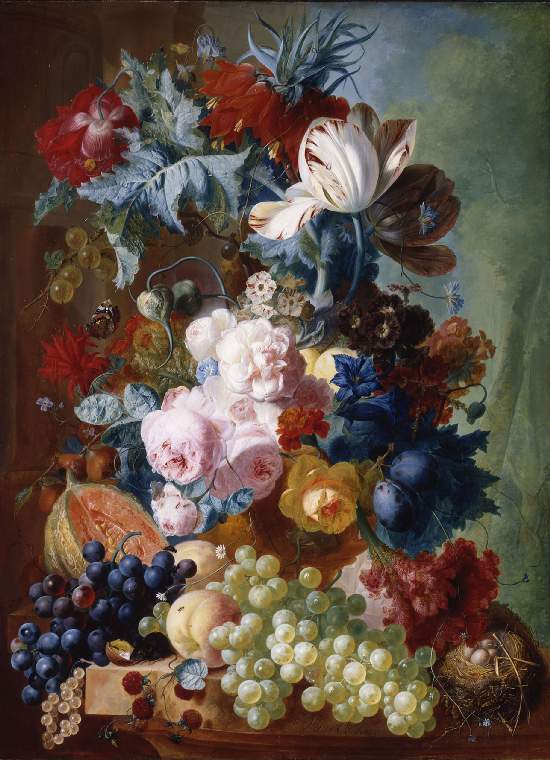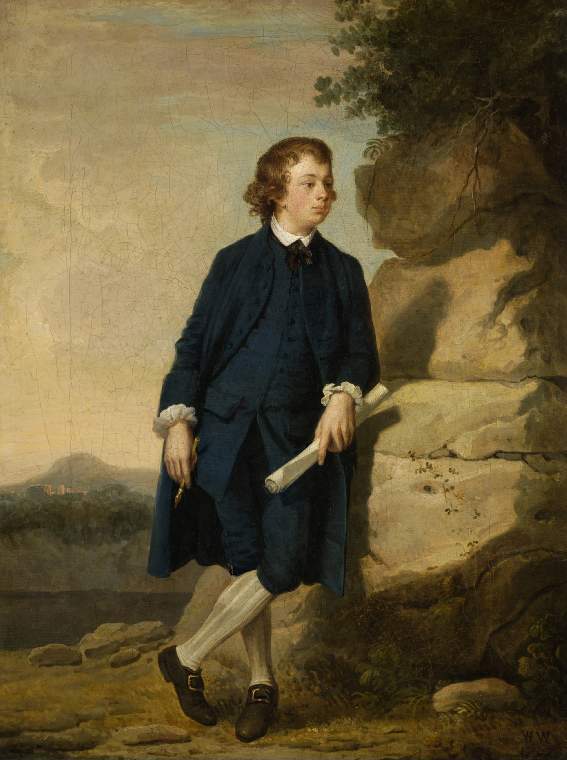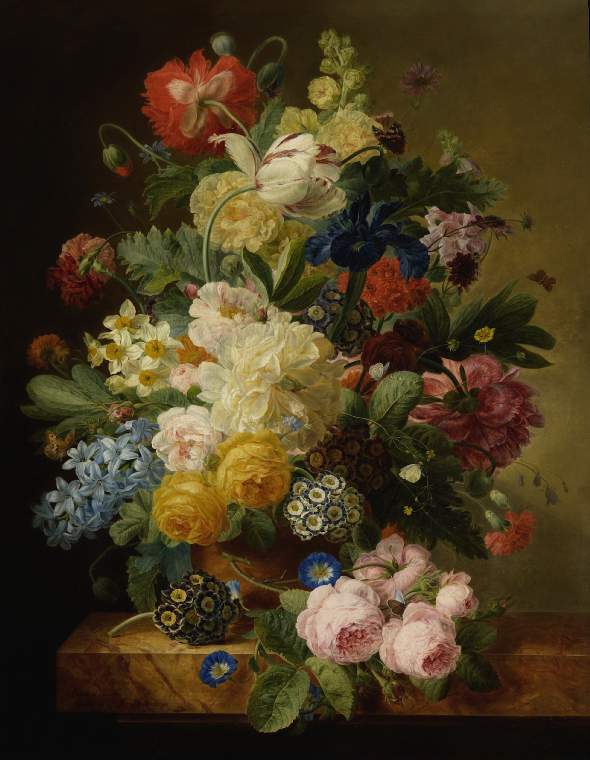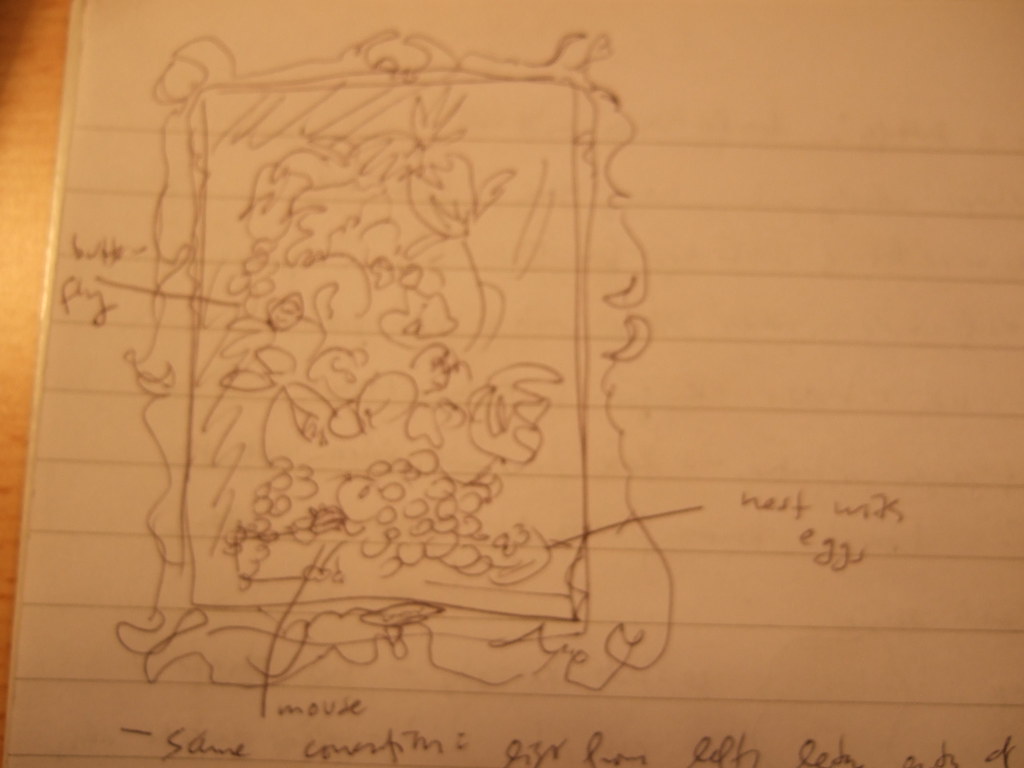Last time, I looked at Mélanie de Comoléra's Vase of Mixed Flowers.
Today it's the turn of:
Jan van Os, Vase of Mixed Flowers.
 |
| Jan van Os (1744-1808, Dutch), Vase of Mixed Flowers. Image source © Fitzwilliam Museum. |
I gave myself 5 minutes with this painting -- but ended up doing 8!
Title
The full title on the museum label is: Vase of mixed flowers, including poppies, Crown Imperial, tulips, roses, auricula and gentian on a stone ledge with a bird's nest, grapes, melon and peaches, with a garden behind.I'm starting to think that these descriptive list-like titles say something about these flower still lifes. There is no hierarchy in this title, just as there is no hierarchy among the objects depicted. Poppies, peaches, roses, eggs -- all are treated with the same careful detail.
What a difference to the kind of hierarchy found, for example, in a portrait or in a religious altarpiece!
 |
| A Young Draughtsman, by an unknown painter, 1767 , ©Fitzwilliam Museum |
This young man is clearly more important than the sketchy landscape behind him or the plants under his feet (nobody can identify these species...) There is a definite hierarchy: the human figure is more important than sky, rock or grass.
Not so in the flower still life.
Format
The format is vertical; that is, the painting is taller than it is wide. This is a 'portrait' format, suited to humans standing upright, and we associate the vertical format with the 'human'.(We tend to associate the horizontal format with landscapes. And reclining nudes.)
So the flowers are treated here a bit like a portrait.
Comparison
The format is the same as that used for Mélanie de Comoléra's still life.
The composition is also similar: we have the light falling from left, the ledge ending at left, the items not cropped by the edge, the same profusion of flowers.
Of dead flowers. We're not in a living garden. These flowers have been cut from their roots and will soon die.
In addition to the flowers, we also have some fruit.
But we also have some humorous signs of animal life!
Fauna
See the black mouse in the foreground? It nibbles on a piece of fruit (or a nut?).And see the nest with its four eggs among spiky stalks of straw.
Notice also the butterfly.
Texture
Look at the velvety peachy texture, the glistening grapes, each with a white highlight. They are ripe to bursting. The cut-open melon shows a sign of human intervention but the melon is now left... to rot? |
Jan van Os, Vase of Mixed Flowers.© Fitzwilliam Museum.
|
The trivial
Remember how the title echoes the non-hierarchical nature of the still life?This is not about power, action, emotion, history, prayer or plot. This is about the minuscule, the trivial, the un-important, the proliferation of material things. Perhaps there is some symbolism hidden away somewhere but mostly I find myself baffled by the thing-ness of the objects and struck by the virtuosity of painterly skill.
The art historian Norman Bryson had this brilliant insight (in his book Looking at the Overlooked: Four Essays on Still Life Painting (1990):
'still-life is the world minus its narratives, or better, the world minus its capacity for generating narrative interest.'
Gallery 17
Gallery 17 is full of these kinds of flower still lifes.
 |
| Jan van Os's picture is the second from the left, above the bust on the right-hand wall. |
There are scores of these pictures. Clearly, flower still lifes were incredibly popular!
The Fitzwilliam website informs us that Gallery 17 houses the collection of Major The Honourable Henry Rogers Broughton, 2nd Lord or Baron Fairhaven, of Anglesey Abbey near Cambridge, donated to the museum upon Fairhaven's death in 1973.
Permalink: http://artincambridge.blogspot.com/2013/03/another-boring-still-life.html



I love these florals still lives. Are there any Jan Van Huysum? He was a miracle painter. In fact he would not let anyone watch him paint for fear they would steal his technique. He painted one flower at a time and waited until the flower he wanted to paint was in season. His technique is amazing and I could stand and have stood in front of one of his for a long time, studied each flowers to figure out "How did he do it?"
ReplyDeleteThanks so much for your comment! To me it's delightful and salutary to know that someone can love the very pictures I find so boring. Now I wonder what you would find boring of the pictures I love... :) I will check for Jan van Huysum. His name rings a bell so I'm almost sure that the Fitz has at least one.
Delete